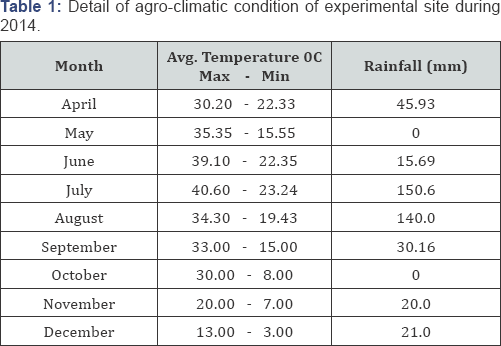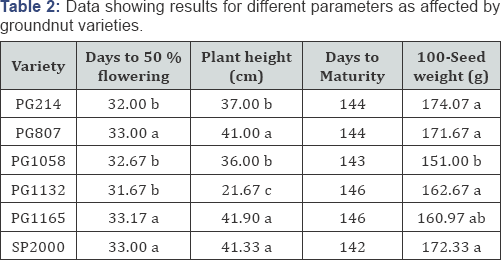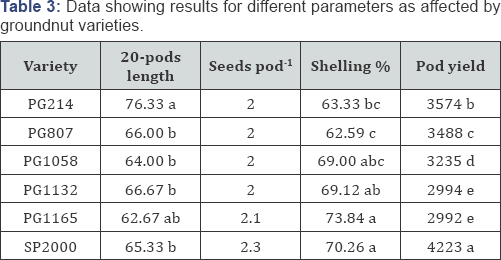Evaluation of Groundnut Varieties for the Agro- Ecological Zone of Malak and Division
Asif Raza*1, Zafar Hayat Khan1, Kamran Khan2, Muhammad Mehran Anjum2, Nawab Ali, Muhammad Owais Iqbal2 and Hazrat Usman2
1Department of Agronomy, Bacha Khan University, Pakistan
2Department of Agronomy, University of Agriculture, Pakistan
Submission: September 28, 2017; Published: October 12, 2017
*Corresponding author: Asif Raza, Department of Agronomy, The Bacha Khan University Charsadda, Pakistan, Email: asifraza886@gmail.com
How to cite this article: Asif R, Zafar H K, Kamran K, M M Anjum, etal. Evaluation of Groundnut Varieties for the Agro-Ecological Zone of Malak and Division. Int J Environ Sci Nat Res. 2017;5(5): 555671. DOI:10.19080/IJESNR.2017.05.555671
Abstract
A field experiment was conducted to evaluate groundnut varieties for the agro-ecological zone of Malak and Division at Agriculture Research Institute (North) Mingora, in 2014. Six groundnut varieties () were evaluated for different agronomic traits. Randomized complete block design with three replications was used in the experiment. Days to 50% flowering, plant height, seed pod-1, 100 seed weight (gm), and seed yield kg ha-1 significantly differ among different genotypes. a genotype PG-1165 and SP-2000 took maximum days to flowering while the lowest days took by PG-1132 and PG-1058 maximum plant height was observed in PG-1165 and SP-2000 while the minimum height was observed in PG- 1132 and PG-1058.Maximum weight of 100 kernel were recorded by SP-2000 and PG-207and the early maturity were recorded by SP-2000 and PG-1058 while the late maturity were recorded by PG-1132 and PG1165 and highest pod length were recorded by PG-214,PG-1132 while the lowest pod length were recorded by PG-1165 and PG-1132 number of seed were maximum counted in PG-1165 pod while minimum in PG-1058,PG-1132,PG-214 and high shelling percentage were recorded by PG-1132 while low recorded by SP-2000 significant difference were recorded by SP-2000 and PG-214 which produce high yield while the lowest yield observed by PG-1058 and PG-1165.Based on results ,the recommended ground variety for adaptation and further research in the rain fed agro climate area were SP-2000 and PG-214.
Introduction
Groundnut Arachis hypogaea [1] L, commonly known as peanut, is a self pollinated legume crop which belongs to family Fabaceae. The crop is grown between 40° N and S latitudes. Its growing period is 90 to 115 days for the sequential branched varieties and 120 to 140 days for the alternately branched varieties. The mean daily temperature for optimum growth is 22 to 28°C. The crop is best adapted to well drained, loose, finable medium texture soils.
Out of total world production of 43.19 million tones, in 2012-13, Asia and Africa produced about 64.1% and 26.3%, respectively (FAOSTAT, 2015). China, India, Nigeria, USA and Sudan are the leading groundnut growing countries of the world. In Pakistan, it is a potential oil seed crop of arid farming and is grown at about 81.5 thousand hectares land with an annual production of 91.4 thousand tones. Average national yield of groundnut dry pods is about 1121 kg ha'1. The province wise distribution showed that about 85% area lies in Punjab, 10% in Khyber Pukhtoonkhwa and 5% in Sindh. Traditionally groundnut is widely used in Pakistan in the roasted form. It is also used in baked product and confectionery. It is an important source of oil (43-55%) and protein (25-28%), hence used as food and feed Din et al. [2]. Groundnut is a good source of edible oil as it contains about 50% oil of good quality. Groundnut oil is one of the best cooking oils due to its high smoking point and is desirable for use in ghee, margarine, shortening and salad oil. The meal contains 25% protein and considered best meal for human consumption and livestock feed. Groundnut is also an excellent source of vitamins and contains high levels of thiamine, riboflavin and niacin.
At present it grown in districts of Karak, Bannu, Kohat and Swabi, of Khyber Pukhtoonkhwa. It is reported that about 58% rainfed land of Khyber Pukhtoonkhwa and 41% land of the Malak and Division remain fallow during summer season Khan et al. [3]. This practice results in low income for farmers and increases soil erosion during monsoon rains. Groundnut, being a drought tolerant crop, can be a cash crop for these lands. Being a valuable crop of arid zones, it requires low input and produces high output for the farmer. Since it is a leguminous crop it can fix atmospheric nitrogen ranging from 40-600 Kg N ha-1 season-1 enhancing soil health. Keeping in mind the importance of this crop, a trial was carried out with an objective to evaluate six groundnut varieties in agro-ecological zone of Malak and, Khyber Pukhtoonkhwa Pakistan, for the commercial cultivation in the areas.
Materials and Methods
The experiment titled "evaluation of groundnut varieties for the agro- ecological zone of Malakand division" was conducted at Agriculture Research Institute North Mingora Swat, during 2014. The objective of this study was to evaluate different genotypes for their production potential and recommend a suitable genotype for cultivation in this area. The experiment was laid in randomized complete block design with three replications. Six different groundnut varieties (PG-214, PG-807, PG-1058, PG- 1132, PG-1165, and SP-2000) were planted. Unshelled seed was planted @100 Kg ha-1 in rows with inter and intra rows space of 45 cm and 15 cm respectively. A basal fertilizer dose of 25 Kg N and 60 Kg P2O5 ha-1 was applied at the time of soil preparation. All standard agronomic practices and plant protection measures were carried out uniformly in all plots to exploit full potential of the varieties. The crop was harvested on different dates as different varieties reached physiological maturity at different times.
Data were recorded on the following parameters:
a) Days to 50% flowering
b) Plant height (cm)
c) Days to maturity
d) 100-Seed weight (g)
e) 20-pods length (cm)
f) Seeds pod-1
g) Shelling percentage
h) Pod yield (Kg ha-1)
Days to 50% flower formation: Days to 50% flower formation were counted by days from sowing to date when 50% of the plants produced flowers in each plot.
Plant height: Height of 10 representative plants in each plot from ground level to plant growing tips was measured in cm to record plant height.
Days to physiological maturity: Days to physiological maturity were recorded by counting days from sowing till plants become physiologically mature.
100-Seeds weight: At physiological maturity, ten plants were selected at random in each plot and data on 100-Seeds weight, Seeds pod-1 was recorded.
20-pods length (cm): Twenty (20) pods were randomly selected from each plot and their length was measured in centimeters.
Shelling percentage: To calculate shelling %, 1000 gm pods were taken from each plot, shells were removed from Seed and then converted into % by following formulae:
Shelling % = (Kernels weight (gm))/(1000 gm)x 100
Pod yield (Kg ha-1): In order to record pod yield kg ha-1, two central rows of each plot were harvested, sundried and weighed to record pod weight, which was multiplied with total number of rows in a plot to calculate pod weight plot-1. The data were then converted into pod yield (Kg ha-1) by using following formulae:
Pod yield (Kg ha-1) = (Pod weigt (kg plot-1))/(Plot size (m2)) x 10,000 m2
Statistical Analysis: Data recorded during the experiment were statistically analyzed and LSD test was applied to signify the differences (Table 1).

Source: All the data was collected from the metrological unit of ARINM Swat.
Results and Discussion
Days to 50% flowering: Flowers are the basic reproductive unit which plays important role in all seed crops Kaba et al [4]. Information regarding flowering is very important in selection for improvement Lim, Gumpil [5]. Early onset of flowering is an important component of early maturity and the first 25 flowers developed mature pods Baily and Bear [6]. Statistical analysis of the data showed that days to 50% flowering were significantly affected by varieties (Table 2). Lowest days to flowering were recorded for PG-1132, PG-1058 and PG-214 while, maximum days were reported for PG-807 and SP-2000. Craufurd et al [7]. Reported that some genotypes of groundnut commenced flowering from 26-34 days after planting. Differences in days to flowering may be due to its genotypic makeup as confirmed by Ishag et al [8].
Plant height (cm): Analysis of the data showed for plant height was significantly affected by groundnut varieties (Table2) . The highest plant height was observed in PG-1165 followed by SP-2000 and PG-807; however they were not significantly different. Whereas the lowest plant height of groundnut was recorded by PG-1132. Since different varieties have different growth rates depending on their genotypes which resulted in different plant heights. These results are in conformity results reported by similar studies by Patidar et al [9] and Dharanguttikar [10].
Days to plant maturity: Statistical analysis of the data revealed that genotypes have no significant variations in their physiological maturity (Table 2). However, PG-1132 took maximum days (146) to physiological maturity and PG-1058 took minimum days to maturity (143 days). These results revealed that all genotypes belong to same maturity group.
100-Seed weight (g): 100-Seed weight is an important yield contributing component in groundnut Aminifar et al. [11]. Genotypes have significantly affected 100-Seed weight of the crop (Table 2). Analysis revealed that highest Seed weight was recorded for PG-214, PG-807, PG-1132 and SP-2000 which may be due to their superior genetic makeup causing high partitioning of assimilates to pods. Lowest Seed weight was recorded for PG-1058. Similar results were recorded by Khan et al. (2001) who evaluated 12 groundnut genotypes in Malak and division, Pakistan and reported significant differences for yield and its attributes.

Means of the same category followed by different letters are significantly different (P≤0.05) using LSD test.
20-pods length (cm): Statistical analysis of the data showed that 20-pods length has been significantly affected by genotypes (Table 3). The highest pod length (76.33 cm) was recorded for PG-214. The lowest pod length was noted in PG-807, PG-1058, PG-1132 and SP-2000; having statistically same pod length. The difference in partitioning of photo-assimilates to the pod shells have resulted in this difference among genotypes.
Seeds pod-1: Genotypes of groundnut have no significant effect on the seeds pod-1 as revealed after statistical analysis (Table 3). However the highest seeds pod-1 was observed in SP- 2000.
Shelling (%): High shelling percentage has been regarded as an important trait in breeding for improvement Lampang et al. [12]. Statistical analysis showed that shelling percentage was significantly affected by the genotypes (Table 3). Highest shelling percentage was recorded in PG-1165 (73.84 %) and SP-2000 (70.26 %). The lowest shelling percentage (62.58) was recorded for PG-807. Hartmond et al. [13]. reported differences in shelling percentage of groundnut genotypes. They asserted that Ca plays an important role in shelling percentage and some genotypes having sensitivity to soil Ca [14].

Means of the same category followed by different letters are significantly different (P≤.05) using LSD test.
Pod yield (Kg ha-1): Analysis of the data revealed that genotypes significantly affected pod yield in groundnut (Table 3) . Highest pod yield (4223 Kg ha-1) was reported in plots planted with SP-2000, while lowest pod yield (2992 and 2994 kg ha-1) was recorded in plots planted with PG-1165 and PG-1132 respectively. Highest yield of SP-2000 may be attributed to the cumulative performance of the genotype in terms of seed pod-1 and shelling percentage [15-18].
Conclusion and Recommendation
Selection and evaluation is an important principle of crop production used to identify high yielding varieties of a crop. In the present experiment six different groundnut varieties were evaluated on the basis of different agronomic parameters at Agriculture Research Institute North, Mingora Swat. Based on the results it is concluded that overall performance of SP- 2000 was highest among the varieties used in the trial and is recommended for planting in agro-ecological conditions of Malak and Division.
References
- Konlan S, S Addo, J Asare, MJ Kombiok (2012) Groundnut (Arachis hypogaea L) varietal response to spacing in the Guinea Savanna agro ecological zone of Ghana Nodulation and nitrogen fixation. Agric Biol JN America 4 (3): 324-335.
- Din NU, A Mahmood, GSS Khattak, I Saeed, MF Hassan (2009) High yielding groundnut (Arachis hypogaea L) variety Golden. Pak J Bot 41(5): 2217-2222.
- Khan A, A Bano, J Bakht, SA Khan, NJ Malik, et al. (2009) Response of exotic groundnut genotypes to environmental diversities at higher altitude of Northern Pakistan. Sarhad J Agric 25(4): 545-550.
- Kaba JS, FK Kumaga, K Ofori (2014) Effect of flower production and time of flowering on pod yield for peanut (Arachis hypogaea L) genotypes. J Agric Vet Sci 7(4): 2319-2372.
- Lim ES, JS Gumpil (1984) The flowering, pollination and hybridization of groundnuts (Arachis hypogaea L) Pertanika 7(2): 61-66.
- Baily WK, JE Bear (1973) Components of earliness of maturity in peanuts (Arachis hypogaea L). J American Peanut Res Educ Assoc 78(1- 2): 59-67.
- Craufurd PQ, TR Wheeler, RH Ellis, RJ Summerfield, PVV Prasad (2000) Escape and tolerance to high temperature at flowering in groundnut (Arachis hypogaea L). J Agri Sci Cambridge 135(4): 371-378.
- Ishag HM (2000) Phenotypic and yield response of irrigated groundnut cultivar in a hot environment. Exp Agric 36: 303-312.
- Patidar S, PK Rai, A Kumar (2014) Int J Emerging Tech Adv Eng 7(9): 500-504.
- Borkar VH, VM Dharanguttikar (2014) Evaluation of groundnut genotypes for physiological traits. Int J Sci Res Public 4(1): 1-8.
- Aminifar J, MM Nik, A Sirousmehr (2013) Grain yield improvement of groundnut (Arachis hypogaea L) under drought stress conditions. Int J Agric Crop Sci 6(12): 819-824.
- Lampang AN, T Charoenwatana, D Tiyawalee (1980) In ICRISAT (International Crops Research Institute for the Semi -Arid Tropics).Proceedings of the International Workshop on Groundnuts Patancheru, Andhra Pradesh, India.
- Hartmond U, JH Williams, F Lenz (1996) Sources of variation in shelling percentage in peanut germplasm and crop improvement for Calcium deficiency-prone soils1. Peanut Sci 23(2): 76-81.
- Bucheyeki TL, EM Shenkalwa, TX Mapunda, LW Matata (2008) On- farm evaluation of promising groundnut varieties for adaptation and adoption in Tanzania. Afr J Agric Res 3(8): 531-536.
- Gyamfi AR, IK Dzomeku, J Lardi (2012) Evaluation of growth and yield potential of genotypes of kersting's groundnut (macrotyloma geocarpum harms) in Northern Ghana. Int Res J Agric S Sci 2(12): 509515.
- Nautiyal PC, PV Zala, RS Tomar, P Sodavadiya, B Tavethia (2011) Evaluation of water use efficient newly developed varieties of groundnut in on-farm trials in two different rainfall areas in Gujarat India. J SAT Agric Res 9: 2-6.
- Ahmad N, M Rahim (2007) Performance of promising groundnut (Arachis hypogea L) varieties for yield and for other character. J Agric Res 45(3):185-189.
- Tarawali AR, DD Quee (2014) Performance of groundnut (Arachis hypogea L) varieties in two agro-ecologies in Sierra Leone. Afr J Agri Res 9(19): 1442-1448.






























